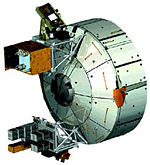
Solar Monitoring Observatory
Encyclopedia

European Space Agency
The European Space Agency , established in 1975, is an intergovernmental organisation dedicated to the exploration of space, currently with 18 member states...
science observatory that is part of the Columbus Laboratory
Columbus (ISS module)
Columbus is a science laboratory that is part of the International Space Station and is the largest single contribution to the ISS made by the European Space Agency ....
, which is a component of the International Space Station
International Space Station
The International Space Station is a habitable, artificial satellite in low Earth orbit. The ISS follows the Salyut, Almaz, Cosmos, Skylab, and Mir space stations, as the 11th space station launched, not including the Genesis I and II prototypes...
. The Columbus module (including SOLAR) was launched February 2008 aboard STS-122
STS-122
STS-122 was a NASA Space Shuttle mission to the International Space Station , flown by the Space Shuttle Atlantis. STS-122 marked the 24th shuttle mission to the ISS, and the 121st space shuttle flight since STS-1....
. SOLAR was externally mounted to the Columbus Laboratory, together with the European Technology Exposure Facility
European Technology Exposure Facility
The European Technology Exposure Facility is a payload mounted on the exterior of the European Columbus laboratory, one of the modules of the International Space Station...
(EuTEF). Some other components are also planned to be mounted externally on Columbus on future missions, including the Atomic Clock Ensemble in Space
Atomic Clock Ensemble in Space
Atomic Clock Ensemble in Space is a project led by the European Space Agency which will place an ultra-stable atomic clock on the International Space Station...
(ACES).
SOLAR consists of three space science instruments: SOVIM, SOLSPEC and SOL-ACES. Together they will provide detailed measurements of the Sun
Sun
The Sun is the star at the center of the Solar System. It is almost perfectly spherical and consists of hot plasma interwoven with magnetic fields...
's spectral irradiance
Irradiance
Irradiance is the power of electromagnetic radiation per unit area incident on a surface. Radiant emittance or radiant exitance is the power per unit area radiated by a surface. The SI units for all of these quantities are watts per square meter , while the cgs units are ergs per square centimeter...
. Once installed on the ISS, Solar is planned to operate continuously for approximately 1.5 years.
The mission was originally planned for a 2003 launch, but was delayed following the Space Shuttle Columbia disaster
Space Shuttle Columbia disaster
The Space Shuttle Columbia disaster occurred on February 1, 2003, when shortly before it was scheduled to conclude its 28th mission, STS-107, the Space Shuttle Columbia disintegrated over Texas and Louisiana during re-entry into the Earth's atmosphere, resulting in the death of all seven crew members...
.
The SOVIM (Solar Variantions and Irradiance Monitor) instrument is based on an earlier instrument (SOVA) which flew aboard the European Retrievable Carrier, launched on STS-46
STS-46
STS-46 was a NASA space shuttle mission using orbiter Atlantis and launched on 31 July 1992 at 9:56:48 am EDT.-Crew:-Mission parameters:*Mass:**Orbiter landing with payload: **Payload: *Perigee: *Apogee:...
in 1992. It is designed to measure solar radiation with wavelengths from 200 nanometers - 100 micrometers. This covers near-ultraviolet
Ultraviolet
Ultraviolet light is electromagnetic radiation with a wavelength shorter than that of visible light, but longer than X-rays, in the range 10 nm to 400 nm, and energies from 3 eV to 124 eV...
, visible
Visible spectrum
The visible spectrum is the portion of the electromagnetic spectrum that is visible to the human eye. Electromagnetic radiation in this range of wavelengths is called visible light or simply light. A typical human eye will respond to wavelengths from about 390 to 750 nm. In terms of...
and infrared
Infrared
Infrared light is electromagnetic radiation with a wavelength longer than that of visible light, measured from the nominal edge of visible red light at 0.74 micrometres , and extending conventionally to 300 µm...
areas of the spectrum.
SOLSPEC (Solar Spectral irradiance measurements) is designed to measure the solar spectral irradiance in the 165 - 3000 nanometer range with high spectral resolution.
SOL-ACES (Auto-calibrating Extreme Ultraviolet and Ultraviolet spectrometers) consists of four grazing incidence grating spectrometer
Spectrometer
A spectrometer is an instrument used to measure properties of light over a specific portion of the electromagnetic spectrum, typically used in spectroscopic analysis to identify materials. The variable measured is most often the light's intensity but could also, for instance, be the polarization...
s. They are designed to measure the EUV/UV spectral regime (17 nanometers - 220 nanometers) with moderate spectral resolution.
The SOLAR platform and its instruments are controlled from the Belgian User Support and Operations Centre (B.USOC), located at the Belgian Institute for Space Aeronomy (BISA) in Uccle
Uccle
Uccle or Ukkel is one of the nineteen municipalities located in the Brussels-Capital Region of Belgium.Uccle is known for its well-to-do areas, its green spots and its high rental rates.-History:...
, Belgium
Belgium
Belgium , officially the Kingdom of Belgium, is a federal state in Western Europe. It is a founding member of the European Union and hosts the EU's headquarters, and those of several other major international organisations such as NATO.Belgium is also a member of, or affiliated to, many...
.

